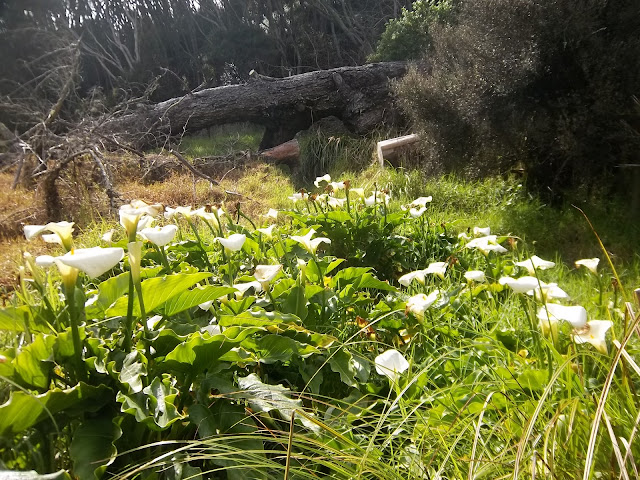We set off
8.15 and it takes nearly 2 hours to get to Lake Otoroa, though that doesinclude
the obligatory coffee & cake stop at Helensville. This is the largest lake
on South Head and has recently been taken over by DOC (Dept. of Conservation).
It’s immediately obvious that it’s a recent acquisition as there’s little info
and the footpath seems to disappear almost before it’s started. So we’re
following a tangled path over and under fallen tree trunks and struggling to find
a way over treacherous terrain around the perimeter of the lake which is more
or less visible through the kanuka trunks.
 |
Lake Otoroa, through the kanuka trees
|
 |
| These arum lilies are growing all around Auckland, they're a native of South Africa |
The internet
info had mentioned gullies full of lilies and sure enough we found them in huge
clumps, flower heads full of bees. They’re arum lilies, a creamy white glowing
in the sunshine. However we decide to retreat, when the path becomes more
trouble than it’s worth, and move on to the next destination: Mosquito Bay.
We’d seen this bay from a boat trip on Kaipara Harbour that we did back in the
Summer, and thought it would be worth a visit. However we hadn’t taken account
of the tides and walked down a very steep track only to find it was high tide
and we couldn’t really explore at all. We meet another English couple also out
exploring for the w/e. No mosquitoes I’m happy to report. Kaipara Harbour is the largest natural harbour in North Island and at the beginning of the twentieth century would have been full of kauri logs, cut down from the forests and floated down rivers into the harbour ready for export.
 |
| Mosquito Bay and Kaipara Harbour with the tide in. Not much exploring to be done |
A long walk
back up the hill and we move onto the Waionui Lagoon, driving through a section
of MOD land. It’s a long drive through pine forest and we’re right at the top
of South Head. The lagoon is really an inlet with a long spit of sand on its
far side, and as the tide’s going we can stroll along the water’s edge towards
the harbour itself. Pine forest descends into dune then mangrove swamp but we
manage to get quite a long way round until we come across a river. So the clump
of pines we’d been aiming for turns out to be on an island and the river separating
us is deep and fast moving so there’s no way we’re getting over there.
 |
This is the clump of pines we're heading for which turns out to be an island
Here we find a man with his daughter cooking sausages for lunch. No other people for miles around, but they’re having a lovely time. He used to live round here as a boy. We continue our walk and head for a line of trees reckoning there’s probably a path back alongside it. Starts off OK but is getting a bit swampy, and before we know it we’re pretty much stuck in the middle of an enormous mangrove swamp. No path, just reeds underfoot between the mangrove bushes which are more or less water-logged.
|
 |
| Finally we get out of the swamp and back to the shore of the lagoon |
Mike’s
wearing shorts and getting scratched legs, and I’m worried about getting
covered in mud, but the boots stay on and hold out and we eventually make it
back to the water’s edge. There’s a lonely woman wandering in search of her
lost dog, but we’ve not seen it in our travels: it’s probably stuck in the
mangroves like we were. Finally back to the car and on our way home.
cool and funny. Only because I know exactly what you mean about the mangroves. My dad always told us to look at the sea floor on low tide. He said if you got no other way but the mangroves you have to go through it, fortunately for us we had our dad teach us how to get around the mangrove swamp and what to look for otherwise we were coming out of there looking like walking mangroves coming off the Kaipara. Thank you and blessed for sharing
ReplyDelete